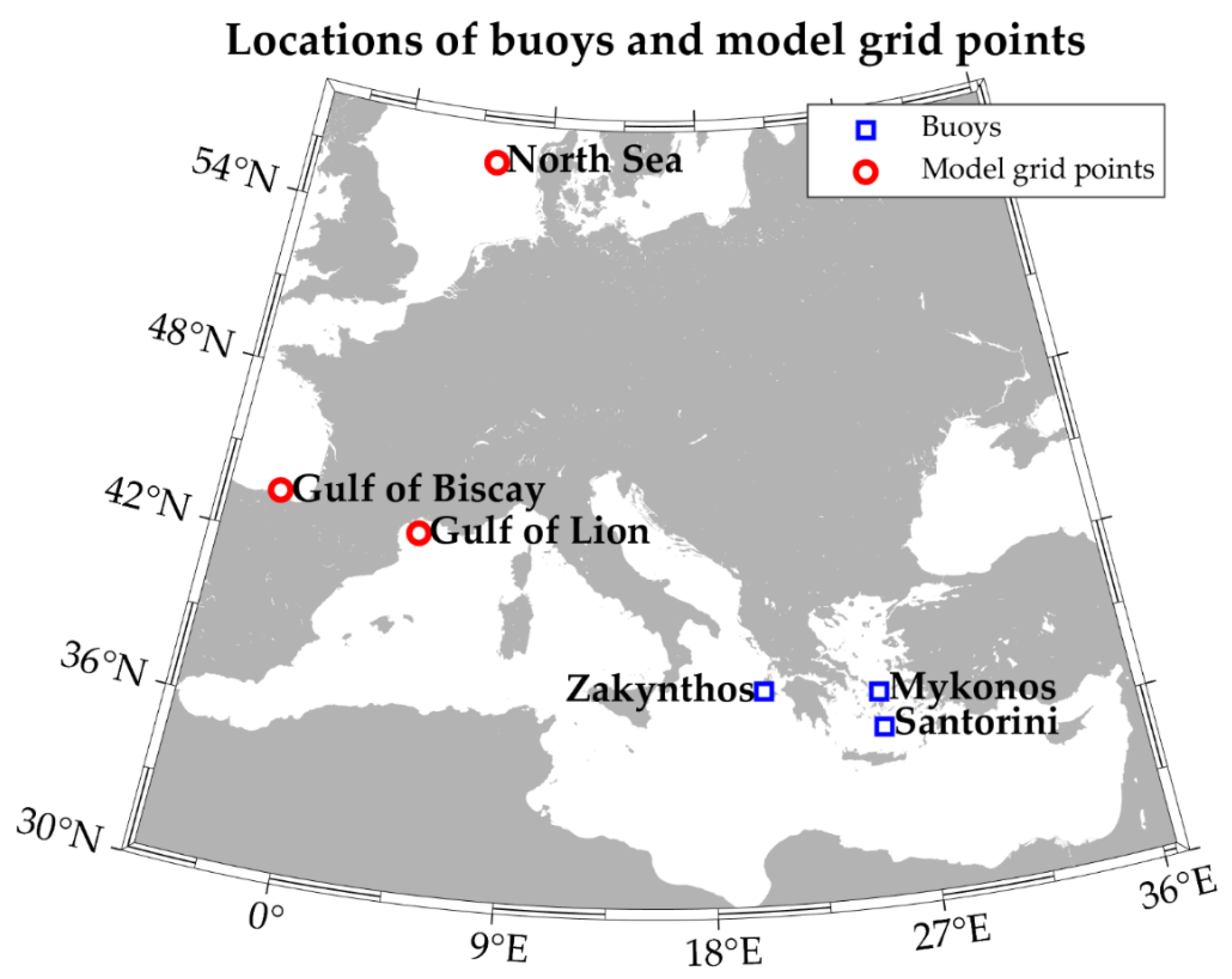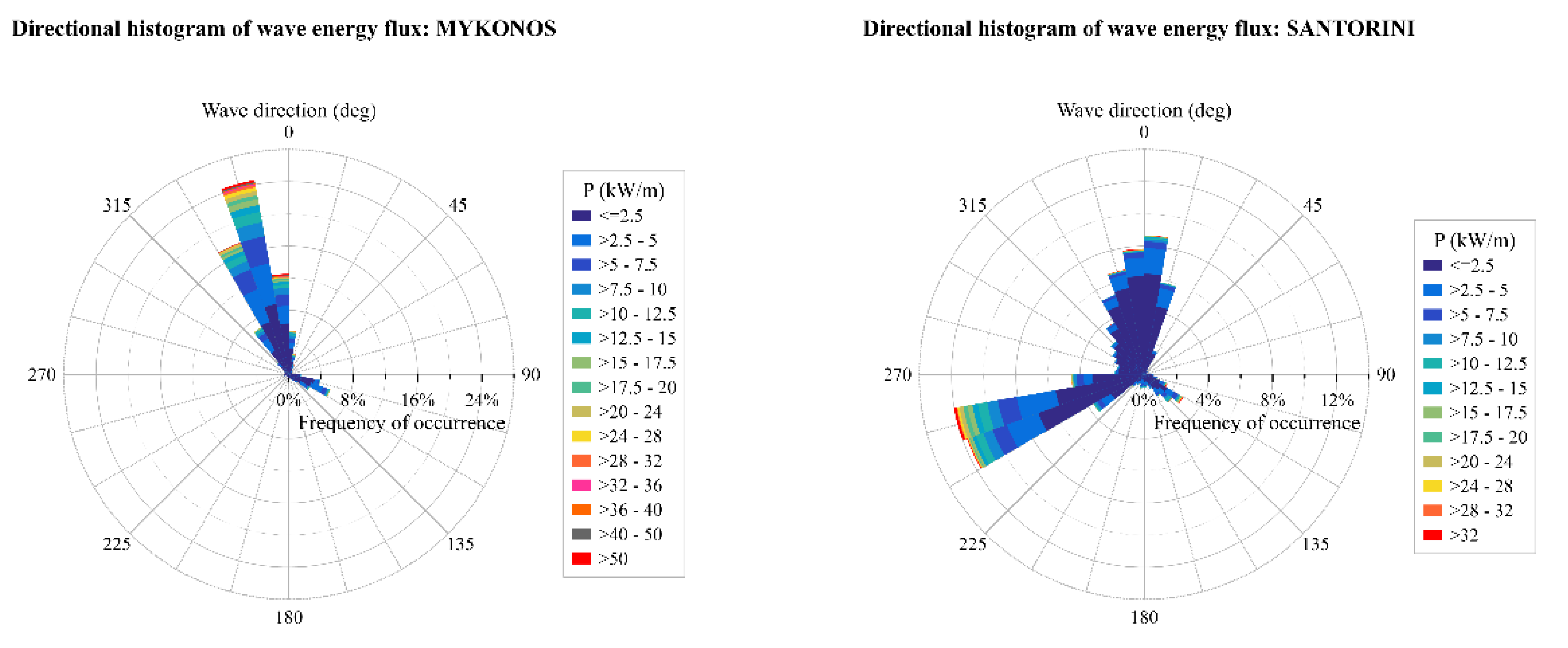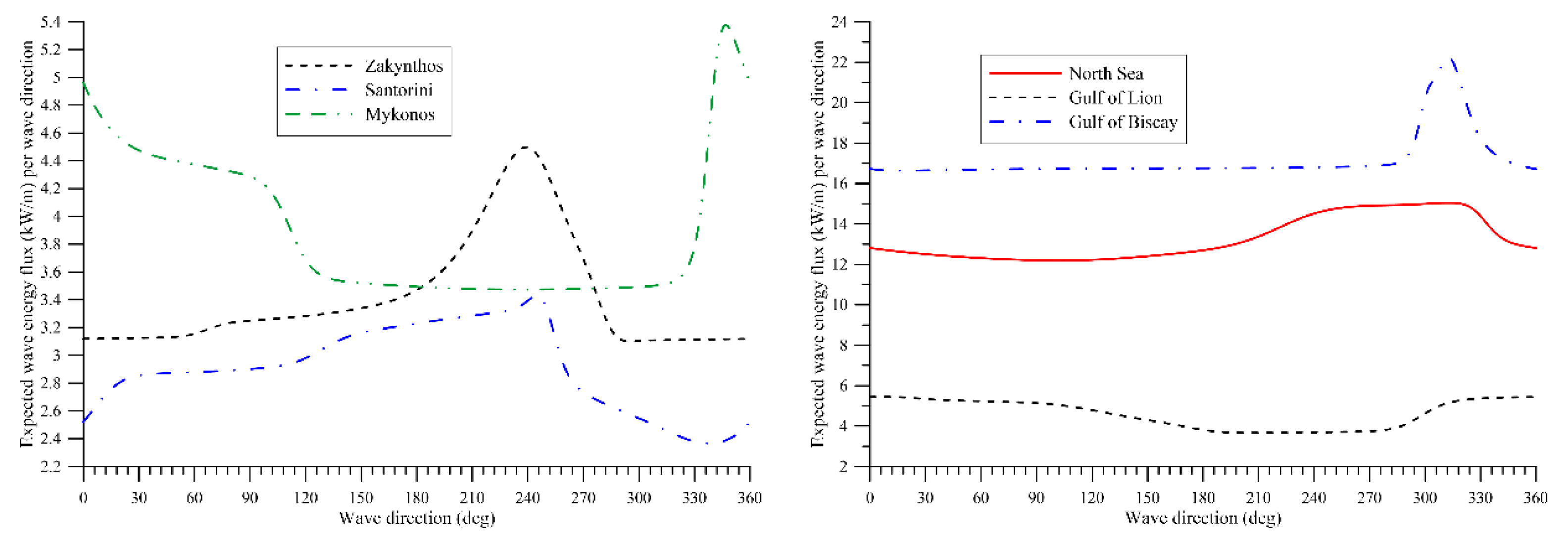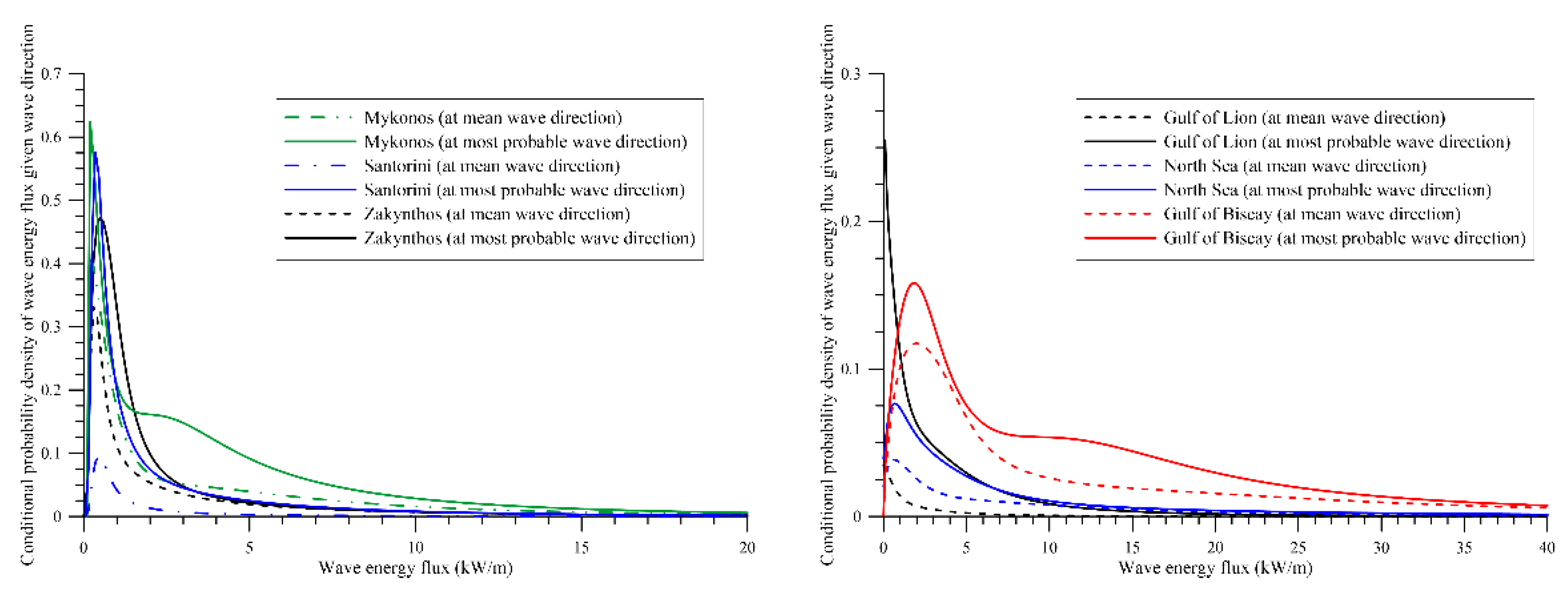Joint Modelling of Wave Energy Flux and Wave Direction
Abstract
1. Introduction
2. Description of Wave Data
3. Univariate Probability Models for Linear and Directional Variables
3.1. Parametric Models for Linear Variables
- (1)
- Two-parameter cdfs: Exponential, Gaussian, Rayleigh;
- (2)
- Three-parameter cdfs: Erlang, Error, Fatigue Life, Fréchet, Gamma, Generalized Extreme Value, Generalized Logistic, Generalized Pareto, Inverse Gaussian, Log-Logistic, Lognormal, Log-Pearson 3, Pearson 5, Weibull;
- (3)
- Four-parameter cdfs: Beta, Burr, Dagum, Generalized Gamma, Johnson SB, Kumaraswamy, Pearson 6.
3.2. Parametric Models for Directional Variables
4. The Johnson–Wehrly Bivariate Model
5. Goodness-of-Fit Testing
5.1. Univariate Distributions
5.2. Bivariate Distributions
6. Numerical Results
6.1. Univariate Distributions for Wave Energy Flux
- (i)
- The overall best fit is provided by ELGN distribution for North Sea (0.9998) and Gulf of Lion (0.9997); LGN distribution for Santorini (0.9995), Gulf of Biscay (0.9999), and Zakynthos (0.9989); and WGEV distribution for Mykonos (0.9987).
- (ii)
- The second-best fit is provided by LGN distribution for North Sea (0.9995), ING distribution for Santorini (0.9994), WGEV distribution for Zakynthos (0.9987), FAL distribution for Mykonos (0.9977), ELGN distribution for Gulf of Biscay (0.9998), and EW distribution for Gulf of Lion (0.9992).
- (iii)
- The third best fit is provided by WGEV distribution for North Sea (0.9993), Gulf of Biscay (0.9995), and Gulf of Lion (0.9992); PE6 distribution for Santorini (0.9992); ING distribution for Zakynthos (0.9981); and GNG distribution for Mykonos (0.9964).
- (i)
- For Mykonos: BUR, ELGN, FAL, GNG, and WGEV distributions;
- (ii)
- For Santorini: DAG, ING, LGN, PE6, and WGEV distributions;
- (iii)
- For Zakynthos: BUR, ING, LGN, PE6, and WGEV distributions;
- (iv)
- For Gulf of Lion: EW, ELGN, FAL, WGEV, and WW distributions;
- (v)
- For Gulf of Biscay: ELGN, ING, LGN, PE6, and WGEV distributions;
- (vi)
- For North Sea: ELGN, EW, LGN, WGEV, and WW distributions.
- (1)
- Conventional distributions: For DAG, BUR, and GNG: ; FAL and LGL: ; LGN: ; PE6: ; GEV: ; ING: ; WEI: ;
- (2)
- Mixture distributions: WGEV: ; WW: ; ELGN: ; EW: .
6.2. Univariate Distributions for Mean Wave Direction
6.3. Joint Pdf for Wave Energy Flux and Direction
7. Application-Oriented Results
8. Conclusions
Author Contributions
Funding
Data Availability Statement
Acknowledgments
Conflicts of Interest
Nomenclature
| English letters | |
| cumulative distribution function of the random variable | |
| probability density function of the random variable | |
| joint (bivariate) cumulative distribution function of the random variables | |
| joint (bivariate) probability density function of the random variables | |
| estimate of obtained from a fitted analytic model | |
| modified Bessel function of the first kind and zero order | |
| sample size | |
| total number of bins | |
| total number of non-empty bins | |
| frequency/probability of occurrence | |
| coefficient of determination for the univariate case | |
| coefficient of determination for the bivariate case | |
| linear random variable | |
| quantile function of the random variable (inverse cumulative distribution function) | |
| wave energy flux | |
| significant wave height | |
| mean wave energy period | |
| mean zero-upcrossing wave period | |
| linear-circular correlation coefficient between the linear variable and the circular variable | |
| Greek letters | |
| mean wave direction (random variable) | |
| Gaussian cumulative distribution and probability density functions, respectively | |
| “correlation-type” parameters for linear and directional random variables in the Johnson—Wehrly model | |
| chi square test or chi square statistic | |
| Abbreviation | |
| A-D | Anderson–Darling (goodness-of-fit test) |
| BIC | Bayesian information criterion |
| BUR | Burr (distribution function) |
| cdf(s) | cumulative distribution function(s) |
| DAG | Dagum (distribution function) |
| ELGN | Exponential–lognormal mixture distribution |
| EW | Exponential–Weibull mixture distribution |
| FAL | Fatigue Life (distribution function) |
| GEV | Generalized Extreme Value (distribution function) |
| GNG | Generalized Gamma (distribution function) |
| IA | index of agreement |
| ING | Inverse Gaussian (distribution function) |
| JW | Johnson–Wehrly |
| K-S | Kolmogorov–Smirnov (goodness-of-fit test) |
| LGL | Log-logistic (distribution function) |
| LGN | Lognormal (distribution function) |
| MAE | mean absolute error |
| pdf(s) | probability density function(s) |
| PE6 | Pearson 6 (distribution function) |
| RMSE | root mean square error |
| SC | synthetic criterion |
| vM | von Mises (distribution function) |
| WEI | Weibull (distribution function) |
| WGEV | Mixture of Weibull and Generalized Extreme Value distribution functions |
| WW | Mixture of two Weibull distribution functions |
Appendix A
- (1)
- Lognormal distribution:where is the Laplace integral:
- (2)
- Fatigue Life (Birnbaum–Saunders) distribution:
- (3)
- Dagum distribution:
- (4)
- Burr distribution:
- (5)
- Pearson 6 distribution:
- (6)
- Log-logistic distribution:
- (7)
- Generalized Gamma distribution:
- (8)
- Inverse Gaussian distribution:
- (1)
- Weibull–GEV mixture:where . For , the GEV distribution simplifies in the following:
- (2)
- Weibull mixture:
- (3)
- Exponential–Weibull mixture:where .
- (4)
- Exponential–lognormal mixture:where .
References
- Soukissian, T.H.; Denaxa, D.; Karathanasi, F.; Prospathopoulos, A.; Sarantakos, K.; Iona, A.; Georgantas, K.; Mavrakos, S. Marine Renewable Energy in the Mediterranean Sea: Status and Perspectives. Energies 2017, 10, 1512. [Google Scholar] [CrossRef]
- Garcia, P.Q.; Sanabria, J.G.; Ruiz, J.A.C. The role of maritime spatial planning on the advance of blue energy in the European Union. Mar. Policy 2019, 99, 123–131. [Google Scholar] [CrossRef]
- Besio, G.; Mentaschi, L.; Mazzino, A. Wave energy resource assessment in the Mediterranean Sea on the basis of a 35-year hindcast. Energy 2016, 94, 50–63. [Google Scholar] [CrossRef]
- Arena, F.; LaFace, V.; Malara, G.; Romolo, A.; Viviano, A.; Fiamma, V.; Sannino, G.; Carillo, A. Wave climate analysis for the design of wave energy harvesters in the Mediterranean Sea. Renew. Energy 2015, 77, 125–141. [Google Scholar] [CrossRef]
- Lavidas, G. Selection index for Wave Energy Deployments (SIWED): A near-deterministic index for wave energy converters. Energy 2020, 196, 117131. [Google Scholar] [CrossRef]
- Guillou, N.; Chapalain, G. Annual and seasonal variabilities in the performances of wave energy converters. Energy 2018, 165, 812–823. [Google Scholar] [CrossRef]
- Fairley, I.; Smith, H.C.M.; Robertson, B.; Abusara, M.; Masters, I. Spatio-temporal variation in wave power and implications for electricity supply. Renew. Energy 2017, 114, 154–165. [Google Scholar] [CrossRef]
- Hiles, C.E.; Beatty, S.J.; De Andres, A. Wave energy converter annual energy production uncertainty using simulations. J. Mar. Sci. Eng. 2016, 4, 53. [Google Scholar] [CrossRef]
- Stopa, J.E.; Filipot, J.-F.; Li, N.; Cheung, K.F.; Chen, Y.-L.; Vega, L. Wave energy resources along the Hawaiian Island chain. Renew. Energy 2013, 55, 305–321. [Google Scholar] [CrossRef]
- Allahdadi, M.N.; He, R.; Neary, V.S. Predicting ocean waves along the US east coast during energetic winter storms: Sensitivity to whitecapping parameterizations. Ocean Sci. 2019, 15, 691–715. [Google Scholar] [CrossRef]
- O’Connell, R.; de Montera, L.; Peters, J.L.; Horion, S. An updated assessment of Ireland’s wave energy resource using satellite data assimilation and a revised wave period ratio. Renew. Energy 2020, 160, 1431–1444. [Google Scholar] [CrossRef]
- Ahn, S.; Haas, K.A.; Neary, V.S. Wave energy resource characterization and assessment for coastal waters of the United States. Appl. Energy 2020, 267, 114922. [Google Scholar] [CrossRef]
- Wan, Y.; Zhang, J.; Meng, J.; Wang, J.; Dai, Y. Study on wave energy resource assessing method based on altimeter data—A case study in Northwest Pacific. Acta Oceanol. Sin. 2016, 35, 117–129. [Google Scholar] [CrossRef]
- Sánchez, A.S.; Rodrigues, D.A.; Fontes, R.M.; Martins, M.F.; Kalid, R.D.A.; Torres, E.A. Wave resource characterization through in-situ measurement followed by artificial neural networks’ modeling. Renew. Energy 2018, 115, 1055–1066. [Google Scholar] [CrossRef]
- Hanson, J.L.; Jensen, R.E. Wave system diagnostics for numerical wave models. In Proceedings of the 8th International Workshop on Wave Hindcasting and Forecasting, Oahu, HI, USA, 14–19 November 2004; pp. 231–238. [Google Scholar]
- Allahdadi, M.N.; Gunawan, B.; Lai, J.; He, R.; Neary, V.S. Development and validation of a regional-scale high-resolution unstructured model for wave energy resource characterization along the US East Coast. Renew. Energy 2019, 136, 500–511. [Google Scholar] [CrossRef]
- Christakos, K.; Varlas, G.; Cheliotis, I.; Spyrou, C.; Aarnes, O.J.; Furevik, B.R. Characterization of wind-sea- and swell-induced wave energy along the Norwegian coast. Atmosphere 2020, 11, 166. [Google Scholar] [CrossRef]
- Guillou, N. Estimating wave energy flux from significant wave height and peak period. Renew. Energy 2020, 155, 1383–1393. [Google Scholar] [CrossRef]
- Liberti, L.; Carillo, A.; Sannino, G. Wave energy resource assessment in the Mediterranean, the Italian perspective. Renew. Energy 2013, 50, 938–949. [Google Scholar] [CrossRef]
- Neary, V.S.; Ahn, S.; Seng, B.E.; Allahdadi, M.N.; Wang, T.; Yang, Z.; He, R. Characterization of extreme wave conditions for wave energy converter design and project risk assessment. J. Mar. Sci. Eng. 2020, 8, 289. [Google Scholar] [CrossRef]
- Allahdadi, M.N.C.; Allahyar, N.; McGee, M.R.L. Wave spectral patterns during a historical cyclone: A numerical model for cyclone gonu in the Northern Oman Sea. Open J. Fluid Dynam. 2017, 7, 131–151. [Google Scholar] [CrossRef]
- Cuttler, M.V.; Hansen, J.E.; Lowe, R.J. Seasonal and interannual variability of the wave climate at a wave energy hotspot off the southwestern coast of Australia. Renew. Energy 2020, 146, 2337–2350. [Google Scholar] [CrossRef]
- Wu, W.-C.; Wang, T.; Yang, Z.; García-Medina, G. Development and validation of a high-resolution regional wave hindcast model for U.S. West Coast wave resource characterization. Renew. Energy 2020, 152, 736–753. [Google Scholar] [CrossRef]
- Ulazia, A.; Penalba, M.; Ibarra-Berastegui, G.; Ringwood, J.; Saénz, J. Wave energy trends over the Bay of Biscay and the consequences for wave energy converters. Energy 2017, 141, 624–634. [Google Scholar] [CrossRef]
- Silverman, B.W. Density Estimation for Statistics and Data Analysis; Taylor & Francis: London, UK, 1986. [Google Scholar]
- Scott, D.W. Multivariate Density Estimation: Theory, Practice, and Visualization; Wiley: New York, NY, USA, 1992. [Google Scholar]
- Vanem, E. Joint statistical models for significant wave height and wave period in a changing climate. Mar. Struct. 2016, 49, 180–205. [Google Scholar] [CrossRef]
- Bitner-Gregersen, E.M. Joint met-ocean description for design and operations of marine structures. Appl. Ocean Res. 2015, 51, 279–292. [Google Scholar] [CrossRef]
- Li, W.; Isberg, J.; Chen, W.; Engström, J.; Waters, R.; Svensson, O. Bivariate joint distribution modeling of wave climate data using a copula method. Int. J. Energy Statist. 2016, 4, 1650015. [Google Scholar] [CrossRef]
- Athanassoulis, G.; Belibassakis, K. Probabilistic description of metocean parameters by means of kernel density models 1. Theoretical background and first results. Appl. Ocean Res. 2002, 24, 1–20. [Google Scholar] [CrossRef]
- Ferreira, J.; Soares, C.G. Modelling bivariate distributions of significant wave height and mean wave period. Appl. Ocean Res. 2002, 24, 31–45. [Google Scholar] [CrossRef]
- Lucas, C.; Soares, C.G. Bivariate distributions of significant wave height and mean wave period of combined sea states. Ocean Eng. 2015, 106, 341–353. [Google Scholar] [CrossRef]
- Myrhaug, D.; Leira, B.J.; Holm, H. Wave power statistics for individual waves. Appl. Ocean Res. 2009, 31, 246–250. [Google Scholar] [CrossRef]
- Myrhaug, D.; Leira, B.J.; Holm, H. Wave power statistics for sea states. J. Offshore Mech. Arct. Eng. 2011, 133, 044501. [Google Scholar] [CrossRef]
- López, I.; Andreu, J.; Ceballos, S.; Martínez de Alegría, I.; Kortabarria, I. Review of wave energy technologies and the necessary power-equipment. Renew. Sustain. Energy Rev. 2013, 27, 413–434. [Google Scholar] [CrossRef]
- Pitt, E. Assessment of Performance of Wave Energy Conversion Systems; European Marine Energy Centre Ltd.: London, UK, 2009. [Google Scholar]
- LaFace, V.; Arena, F.; Soares, C.G. Directional analysis of sea storms. Ocean Eng. 2015, 107, 45–53. [Google Scholar] [CrossRef]
- Carballo, R.; E Sanchez, M.; Ramos, V.; Taveirapinto, F.; Iglesias, G. A high resolution geospatial database for wave energy exploitation. Energy 2014, 68, 572–583. [Google Scholar] [CrossRef]
- Iglesias, G.; Carballo, R. Wave energy and nearshore hot spots: The case of the SE Bay of Biscay. Renew. Energy 2010, 35, 2490–2500. [Google Scholar] [CrossRef]
- Soukissian, T.H. Probabilistic modeling of directional and linear characteristics of wind and sea states. Ocean Eng. 2014, 91, 91–110. [Google Scholar] [CrossRef]
- Smith, H.C.M.; Fairley, I.; Robertson, B.; Abusara, M.; Masters, I. Wave resource variability: Impacts on wave power supply over regional to international scales. Energy Procedia 2017, 125, 240–249. [Google Scholar] [CrossRef][Green Version]
- Amrutha, M.M.; Kumar, V.S. Spatial and temporal variations of wave energy in the nearshore waters of the central west coast of India. Ann. Geophys. 2016, 34, 1197–1208. [Google Scholar] [CrossRef]
- Wei, K.; Arwade, S.R.; Myers, A.T.; Valamanesh, V.; Pang, W. Effect of wind and wave directionality on the structural performance of non-operational offshore wind turbines supported by jackets during hurricanes. Wind. Energy 2016, 20, 289–303. [Google Scholar] [CrossRef]
- Barj, L.; Stewart, S.; Stewart, G.; Lackner, M.; Jonkman, J.; Robertson, A. Wind/Wave Misalignment in the Loads Analysis of a Floating Offshore Wind Turbine; National Renewable Energy Lab (NREL): Golden, CO, USA, 2014. [Google Scholar]
- Bachynski, E.E.; Kvittem, M.I.; Luan, C.; Moan, T. Wind-wave misalignment effects on floating wind turbines: Motions and tower load effects. J. Offshore Mech. Arct. Eng. 2014, 136, 041902. [Google Scholar] [CrossRef]
- Lisboa, R.C.; Teixeira, P.R.; Fortes, C.J. Numerical evaluation of wave energy potential in the south of Brazil. Energy 2017, 121, 176–184. [Google Scholar] [CrossRef]
- Soukissian, T.H.; Karathanasi, F.E. On the selection of bivariate parametric models for wind data. Appl. Energy 2017, 188, 280–304. [Google Scholar] [CrossRef]
- Vega, J.L.; Rodríguez, G. Modelling mean wave direction distribution with the Von Mises model. WIT Trans. Ecol Environ. 2009, 126, 3–14. [Google Scholar]
- Tofallis, C. Selecting the best statistical distribution using multiple criteria. Comput. Ind. Eng. 2008, 54, 690–694. [Google Scholar] [CrossRef][Green Version]
- Erdem, E.; Shi, J. Comparison of bivariate distribution construction approaches for analysing wind speed and direction data. Wind. Energy 2011, 14, 27–41. [Google Scholar] [CrossRef]
- Soukissian, T.; Chronis, G. Poseidon: A marine environmental monitoring, forecasting and information system for the Greek seas. Mediterr. Mar. Sci. 2000, 1, 71. [Google Scholar] [CrossRef]
- Soukissian, T.H.; Chronis, G.T.; Nittis, K.; Diamanti, C. Advancement of operational oceanography in Greece: The case of the Poseidon system. J. Atmospheric Ocean Sci. 2002, 8, 93–107. [Google Scholar] [CrossRef]
- Korres, G.; Ravdas, M.; Zacharioudaki, A. Mediterranean Sea Waves Hindcast (CMEMS MED-Waves 2006–2017) (Version 1) [Data Set]. Copernicus Monitoring Environment Marine Service (CMEMS). Available online: https://doi.org/10.25423/CMCC/MEDSEA_HINDCAST_WAV_006_0122019 (accessed on 15 December 2020).
- Poli, P.; Hersbach, H.; Dee, D.P.; Berrisford, P.; Simmons, A.J.; Vitart, F.; Laloyaux, P.; Tan, D.G.H.; Peubey, C.; Thépaut, J.-N.; et al. ERA-20C: An atmospheric reanalysis of the twentieth century. J. Clim. 2016, 29, 4083–4097. [Google Scholar] [CrossRef]
- Romolo, A.; Arena, F. On Adler space-time extremes during ocean storms. J. Geophys. Res. Oceans 2015, 120, 3022–3042. [Google Scholar] [CrossRef]
- Romolo, A.; Malara, G.; Laface, V.; Arena, F. Space–time long-term statistics of ocean storms. Probabilist. Eng. Mech. 2016, 44, 150–162. [Google Scholar] [CrossRef]
- Fedele, F.; Lugni, C.; Chawla, A. The sinking of the El Faro: Predicting real world rogue waves during Hurricane Joaquin. Sci. Rep. 2017, 7, 11188. [Google Scholar] [CrossRef]
- Fisher, N.I. Statistical Analysis of Circular Data, 1st ed.; Cambridge University Press: Cambridge, UK, 1993. [Google Scholar]
- Galanis, G.; Chu, P.C.; Kallos, G.; Kuo, Y.-H.; Dodson, C.T.J. Wave height characteristics in the north Atlantic ocean: A new approach based on statistical and geometrical techniques. Stoch. Environ. Res. Risk Assess. 2011, 26, 83–103. [Google Scholar] [CrossRef]
- Teixeira, R.; Nogal, M.; O’Connor, A. On the suitability of the generalized Pareto to model extreme waves. J. Hydraul. Res. 2018, 56, 755–770. [Google Scholar] [CrossRef]
- Masseran, N.; Razali, A.M.; Ibrahim, K.; Latif, M.T. Fitting a mixture of von Mises distributions in order to model data on wind direction in Peninsular Malaysia. Energy Convers. Manag. 2013, 72, 94–102. [Google Scholar] [CrossRef]
- Directional: A Collection of R Functions for Directional Data Analysis. Available online: https://cran.r-project.org/web/packages/Directional (accessed on 16 December 2020).
- movMF: Mixtures of von Mises-Fisher Distributions. Available online: https://cran.r-project.org/web/packages/movMF (accessed on 18 December 2020).
- Dong, S.; Wang, N.; Lu, H.; Tang, L. Bivariate distributions of group height and length for ocean waves using Copula methods. Coast. Eng. 2015, 96, 49–61. [Google Scholar] [CrossRef]
- Antão, E.; Soares, C.G. Approximation of bivariate probability density of individual wave steepness and height with copulas. Coast. Eng. 2014, 89, 45–52. [Google Scholar] [CrossRef]
- Qu, X.; Shi, J. Bivariate modeling of wind speed and air density distribution for long-term wind energy estimation. Int. J. Green Energy 2010, 7, 21–37. [Google Scholar] [CrossRef]
- Athanassoulis, G.A.; Skarsoulis, E.K.; Belibassakis, K.A. Bivariate distributions with given maringals with an application to wave climate description. Appl. Ocean Res. 1994, 16, 1–17. [Google Scholar] [CrossRef]
- Johnson, R.A.; Wehrly, T.E. Some angular-linear distributions and related regression models. J. Am. Stat. Assoc. 1978, 73, 602. [Google Scholar] [CrossRef]
- Zhou, J.; Erdem, E.; Li, G.; Shi, J. Comprehensive evaluation of wind speed distribution models: A case study for North Dakota sites. Energy Convers. Manag. 2010, 51, 1449–1458. [Google Scholar] [CrossRef]
- Kollu, R.; Rayapudi, S.R.; Narasimham, S.; Pakkurthi, K.M. Mixture probability distribution functions to model wind speed distributions. Int. J. Energy Environ. Eng. 2012, 3, 27. [Google Scholar] [CrossRef]
- Soukissian, T. Use of multi-parameter distributions for offshore wind speed modeling: The Johnson S-B distribution. Appl. Energy 2013, 111, 982–1000. [Google Scholar] [CrossRef]
- Ouarda, T.; Charron, C.; Shin, J.-Y.; Marpu, P.; Al-Mandoos, A.; Al-Tamimi, M.; Ghedira, H.; Al Hosary, T. Probability distributions of wind speed in the UAE. Energy Convers. Manag. 2015, 93, 414–434. [Google Scholar] [CrossRef]
- Ramanathan, R. Selecting the best statistical distribution—A comment and a suggestion on multi-criterion evaluation. Comput. Ind. Eng. 2005, 49, 625–628. [Google Scholar] [CrossRef]
- Wang, Y.; Yam, R.C.; Zuo, M.J. A multi-criterion evaluation approach to selection of the best statistical distribution. Comput. Ind. Eng. 2004, 47, 165–180. [Google Scholar] [CrossRef]








| Location Name | Latitude, Longitude (°) | Observation Period | Sample Size | Depth (m) |
|---|---|---|---|---|
| Mykonos | 37.51° N, 25.46° E | 2007–2010 | 7406 | −92 |
| Santorini | 36.25° N, 25.49° E | 2007–2010 | 8613 | −342 |
| Zakynthos | 37.85° N, 20.36° E | 2007–2010 | 5002 | −2,072 |
| Gulf of Lion | 42.98° N, 4.00° E | 2006–2010 | 14,364 | −95 |
| Gulf of Biscay | 43.60° Ν, 3.00 W | 2006–2010 | 14,364 | −288 |
| North Sea | 56.25° N, 5.62° E | 2006–2010 | 14,608 | −48 |
| Location Name | kW/m | kW/m | kW/m | kW/m | % | ||
|---|---|---|---|---|---|---|---|
| Mykonos | 4.634 | 2.136 | 135.961 | 8.031 | 173.31 | 6.155 | 60.025 |
| Santorini | 2.852 | 1.350 | 96.760 | 4.807 | 168.536 | 6.138 | 63.977 |
| Zakynthos | 3.720 | 1.567 | 101.183 | 6.747 | 181.389 | 5.870 | 53.964 |
| Gulf of Lion | 4.587 | 1.605 | 224.762 | 9.185 | 200.229 | 8.436 | 127.003 |
| Gulf of Biscay | 20.652 | 8.506 | 612.400 | 37.290 | 180.569 | 5.210 | 41.049 |
| North Sea | 14.465 | 5.801 | 491.759 | 25.340 | 175.184 | 4.975 | 42.137 |
| Location Name | deg | deg | |||
|---|---|---|---|---|---|
| Mykonos | 353.65 | 76.07 | 0.595 | 0.405 | 0.900 |
| Santorini | 301.31 | 285.82 | 0.407 | 0.593 | 1.089 |
| Zakynthos | 249.69 | 253.96 | 0.628 | 0.372 | 0.862 |
| Gulf of Lion | 256.89 | 285.60 | 0.130 | 0.870 | 1.319 |
| Gulf of Biscay | 312.98 | 308.49 | 0.904 | 0.096 | 0.439 |
| North Sea | 286.93 | 294.99 | 0.415 | 0.585 | 1.081 |
| Locations | Probability Distributions and Parameters | ||||
|---|---|---|---|---|---|
| Mykonos | BUR | ELGN | FAL | GNG | WGEV |
| 2.162, 0.975, 5.470, 0.099 | 8.388, 0.535, 1.253, 0.164 | 1.687, 1.879, 0.070 | 0.295, 5.866, 0.006, 0.098 | 2.541, 0.500, 0.657, 2.107, 2.366, 0.248 | |
| Santorini | DAG | ING | LGN | PE6 | WGEV |
| 1.296, 1.284, 0.917, 0.124 | 1.079, 2.798, 0.054 | 1.246, 0.222, 0.121 | 1.837, 1.560, 0.998, 0.123 | 4.741, 0.330, 0.776, 0.926, 1.064, 0.072 | |
| Zakynthos | BUR | ING | LGN | PE6 | WGEV |
| 1.442, 1.069, 2.259, 0.133 | 1.131, 3.720, 0.000 | 1.435, 0.317, 0.129 | 1.215, 1.485, 1.823, 0.133 | 3.317, 0.401, 0.797, 1.363, 1.455, 0.173 | |
| Gulf of Lion | EW | ELGN | FAL | WGEV | WW |
| 0.531, 0.770, 5.213, 0.280 | 0.533, 1.556, 0.991, 0.446 | 2.046, 1.474, −0.027 | 1.034, 0.653, 0.501, 3.256, 4.122, 0.510 | 0.752, 4.773, 1.238, 0.412, 0.779 | |
| Gulf of Biscay | ELGN | ING | LGN | PE6 | WGEV |
| 67.660, 2.001, 1.215, 0.098 | 6.641, 21.057, −0.405 | 1.363, 2.122, 0.151 | 1.456, 1.462, 8.341, 0.171 | 1.672, 3.171, 0.681, 9.622, 11.027, 0.321 | |
| North Sea | ELGN | EW | LGN | WGEV | WW |
| 1.026, 1.890, 1.347, 0.073 | 5.397, 0.854, 25.724, 0.599 | 1.428, 1.744, −0.050 | 0.797, 15.952, 0.896, 2.506, 2.298, 0.529 | 1.029, 5.205, 0.842, 24.339, 0.568 | |
| Locations | ||||||
|---|---|---|---|---|---|---|
| Parameters, | Mykonos | Santorini | Zakynthos | Gulf of Lion | Gulf of Biscay | North Sea |
| 9.07, 0.22, 39.79, 31.42 | 61.22, 33.96, 10.38, 1.13, 2.58, 22.99, 23.52 | 41.69, 8.73, 48.06, 4.78, 0.57 | 52.47, 16.17, 1.91, 25.29, 7.87, 16.01, 6.54, 2.26, 3.53, 6.13, 17.38, 3.16 | 33.18, 61.92, 1.27, 4.62 | 4.70, 1.22, 5.40, 39.32, 1.60 | |
| −0.17, −3.10, −0.32, 1.99 | −1.94, −1.88, −0.41, 2.79, −1.34, 0.07, 2.24 | 1.12, −1.92, −1.33, −2.49, −2.99 | 0.35, −1.00, −1.34, −1.15, 2.06, −1.03, 2.82, −0.27, −2.30, −0.92, −3.08, 0.39 | −0.79, −1.01, −0.41, −0.41 | −2.26, 0.07, −1.11, −0.53, 2.21 | |
| 0.25, 0.16, 0.46, 0.13 | 0.19, 0.09, 0.18, 0.12, 0.14, 0.22, 0.06 | 0.06, 0.31, 0.25, 0.22, 0.16 | 0.05, 0.06, 0.05, 0.14, 0.16, 0.06, 0.14, 0.06, 0.05, 0.04, 0.11, 0.08 | 0.28, 0.46, 0.10, 0.15 | 0.26, 0.13, 0.26, 0.18, 0.16 | |
| Distributions | Locations | |||||
|---|---|---|---|---|---|---|
| Mykonos | Santorini | Zakynthos | Gulf of Lion | Gulf of Biscay | North Sea | |
| BUR | 1291 | 9328 | ||||
| DAG | 781 | |||||
| ELGN | 1085 | 347 | 2629 | 4058 | ||
| EW | 329 | 3780 | ||||
| FAL | 1191 | 299 | ||||
| GNG | 1376 | |||||
| ING | 865 | 10,194 | ||||
| LGN | 814 | 5337 | 2249 | 3717 | ||
| PE6 | 793 | 6861 | 2633 | |||
| WGEV | 1144 | 689 | 8253 | 335 | 2743 | 3742 |
| WW | 325 | 2430 | 3806 | |||
Publisher’s Note: MDPI stays neutral with regard to jurisdictional claims in published maps and institutional affiliations. |
© 2021 by the authors. Licensee MDPI, Basel, Switzerland. This article is an open access article distributed under the terms and conditions of the Creative Commons Attribution (CC BY) license (http://creativecommons.org/licenses/by/4.0/).
Share and Cite
Soukissian, T.H.; Karathanasi, F.E. Joint Modelling of Wave Energy Flux and Wave Direction. Processes 2021, 9, 460. https://doi.org/10.3390/pr9030460
Soukissian TH, Karathanasi FE. Joint Modelling of Wave Energy Flux and Wave Direction. Processes. 2021; 9(3):460. https://doi.org/10.3390/pr9030460
Chicago/Turabian StyleSoukissian, Takvor H., and Flora E. Karathanasi. 2021. "Joint Modelling of Wave Energy Flux and Wave Direction" Processes 9, no. 3: 460. https://doi.org/10.3390/pr9030460
APA StyleSoukissian, T. H., & Karathanasi, F. E. (2021). Joint Modelling of Wave Energy Flux and Wave Direction. Processes, 9(3), 460. https://doi.org/10.3390/pr9030460







